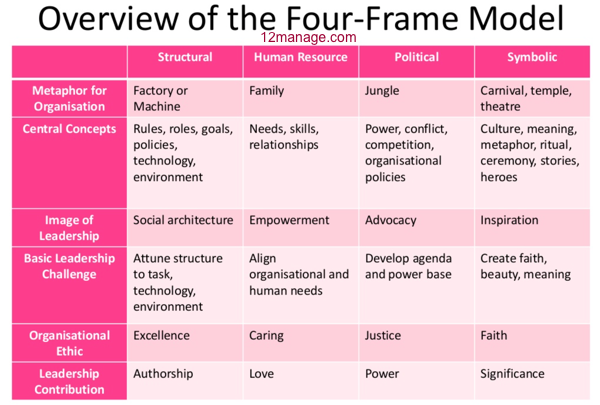The Four Frames
The four frames are guides that can be used to evaluate a complex situation and determine solutions. Reframing it with these lenses provides insights regarding the root causes behind an issue, possible paths for forward progress, and methods for achieving the desired goal. Analysis from a single viewpoint rarely offers the complete picture. Organizations and people are complex entities, requiring thoughtful analysis when evaluating, motivating, or initiating change. Using this organizational theory from Bolman and Deal will allow one to gain clarity of the task at hand and develop a roadmap for the most efficient and appropriate strategies for achieving success.
ISSC Work
Question 1: What is our common understanding of how the frame applies to our college?
Questions 2: Looking at this frame from both the student role and the professional/practitioner role, what questions should be posed to projects/programs to evaluate the frame as related to centering blackness?
- Student Services: JamBoard Link
- Teaching Faculty: JamBoard Link

Bolman and Deal’s Four Frames Model:
Structural
This frame focuses on the “how” of change. It primarily focuses on strategy; clarifying tasks and responsibilities; setting measurable goals and deadlines; and creating systems and protocols. This frame is well-suited for organizations and managers that deal in analysis and logic. Roles and goals are generally well-defined. The emphasis is on rationality, facts, and data. The organization itself can be thought of as a machine, requiring precision movements of many cogs. As such, a leader or project will need to be direct, focused, and methodical.
- Organizational structure / Governance
- Clear structure for the task & environment
- Policies/Procedures
- Rules
- Authority
- Facts, tasks, logic
Human Resource
This frame is focused on the individual, their needs, and their value within an organization. The emphasis is on giving individuals the power and opportunity to perform their given responsibilities well. Interpersonal skills are critically important as coaching, motivation, guidance, and support of the individual are key in establishing the role and fit. The organizational goal is often empowerment and job satisfaction.
- Support & empowerment
- Morale considerations
- The "right" people for the job
- The "right" attitudes, skills and behaviors for the endeavor
- Are needs taken care of (think hierarchy of needs)?
Symbolic
This frame is often described as theatrical because the focus is on aligning individual goals with organizational goals to create a sense of purpose or meaning in one’s work. The project manager/lead must be a charismatic visionary with the ability to excite and motivate through storytelling and showmanship. The leader should ensure that there is a motivating vision and actively recognize excellent performance in their team members.
- Symbols
- Stories
- Foundational legends
- Visual representations
- Strong vision, story
Political
This frame emphasizes the importance of addressing conflicts between individuals or differing interest groups. The characteristics of an organization viewed through this lens include scarcity, power, allies, and deal-brokering. Leaders need advocacy, networking, and negotiation skills. The emphasis is on using any and all assets to maximize the benefits to the unit, organization, or workforce with the recognition that not all needs may be met.
- Relationships
- Connections
- Interest groups / constituencies
- Conflict & limited resources
- Negotiations/ buy-in, working with different groups
- Key champions
Adapted from: https://icenetblog.royalcollege.ca/2019/04/09/education-theory-made-practical-3-bolman-and-deals-four-frame-model/
REFRAMING ORGANIZATIONS: A FOUR-FRAME MODEL PRESENTATION by Natasha N. Johnson